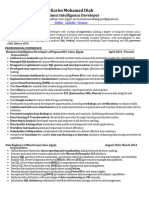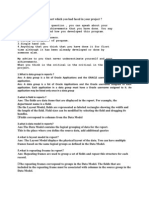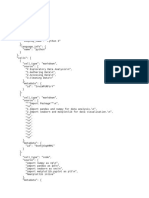Lab 9 SQL SELECT With Functions, Aggregate Functions
Uploaded by
Daniyal AhmedLab 9 SQL SELECT With Functions, Aggregate Functions
Uploaded by
Daniyal AhmedLab Manual for Introduction to Database Systems
Lab-09: SQL SELECT (FUNCTIONS, AGGREGATE FUNCTIONS AND ARITHMETIC
OPERATIONS)
Lab 09:SQL SELECT (FUNCTIONS, AGGREGATE FUNCTIONS AND ARITHMETIC OPERATIONS)
Contents
1. Introduction 3
2. Activity Time boxing 3
3. Objective of the experiment 3
4. Concept Map 4
4.1. Date/Time Functions 4
4.2. String Functions 4
4.2.1. Adding text to an existing value 4
4.2.2. Changing Part of a String 5
4.2.3. Finding a piece of text in a string. 5
4.3. Numeric Functions 5
4.4. Aggregate/Summarizing Functions 5
4.5.1. AVG() 6
4.5.2. MIN() and MAX() 6
4.5.3. SUM() 7
4. Homework before Lab 7
5.1. Problem Solution Modeling 7
5.1.1. Problem description: 7
5. Procedure& Tools 7
6.1. Tools 7
6.2. Setting-up and Setting up XAMPP (MySQL, Apache) [Expected time =
5mins] 7
6.3. Walkthrough Task [Expected time = 30mins] 7
6.3.1. String Functions 7
Department of Computer Science, Page 1
C.U.S.T.
Lab 09:SQL SELECT (FUNCTIONS, AGGREGATE FUNCTIONS AND ARITHMETIC OPERATIONS)
6.3.2. Date/Time Functions 8
6.3.3. Replace Function: 8
6.3.4. Locate Function 9
6.3.5. Numeric Functions 9
6.3.6. Aggregate/Average Functions 10
6.3.7. Aggregate/Min, Max Functions 10
6.3.8. Aggregate/SUM Functions 11
6. Practice Tasks 11
7.1. Practice Task 1 [Expected time = 40mins] 12
7. Evaluation Task (Unseen) [Expected time = 55mins for two tasks] 12
8. Evaluation criteria 12
9. Further Reading 12
10. Books 12
b) Slides 12
11. REFERENCES: 13
Department of Computer Science, Page 2
C.U.S.T.
Lab 09:SQL SELECT (FUNCTIONS, AGGREGATE FUNCTIONS AND ARITHMETIC OPERATIONS)
Lab09: SQL SELECT (FUNCTIONS, AGGREGATE FUNCTIONS
AND ARITHMETIC OPERATIONS)
1. Introduction
This lab is a continuation of the last lab. So far, we have learned how to query subset of data
from the database using SELECT statement, we have simply displayed the results of any query.
MySQL can do more that this and has many built in functions that can transform data to meet our
requirements. These include:
• Date Functions are used to manipulate the display format of a date as well as calculate
time.i.e. Formatting the date using DATE_FORMAT() function, or getting year from date
using YEAR() function.
• String Functions can format or manipulate a text string.i.e. Adding text to an existing value
using CONCAT() function or getting a substring from text using RIGHT, LEFT, or MID
functions.
• Numeric Functions can format or manipulate figures/numbers.i.e. getting floor or ceiling
value using FLOOR() or CEILING() functions respectively.
• Aggregate/Summarizing Functions are used to get a summarized/aggregate result from a
query. i.e. counting the number of rows in the ResultSet of a query using COUNT() function.
There are also Control Functions that can be used to give conditionality to queries.In this lab,
you can learn about the select command using functions.
Relevant Lecture Material
a) Text Book: Java: Text Book: Database Systems, A practical approach to design,
implementation and management by Thomas Connolly, Carolyn Begg, Addison
Wesley, Fifth Edition,
1. Read URL:
• https://www.w3schools.com/sql/sql_min_max.asp
• https://www.w3schools.com/sql/sql_count_avg_sum.asp
2. Activity Time boxing
Table 1: Activity Time Boxing
Task No. Activity Name Activity time Total Time
6.3 Walkthrough Tasks 30mins 60mins
7 Practice tasks 20 to 30mins for each task 50mins
8 Evaluation Task 40mins for all assigned task 40mins
3. Objective of the experiment
• To get basic understanding ofMySQL functions i.e. DATE functions, String function,
Numeric functions, and Aggregate functions.
• To get familiar with querying a database using SELECT statement with functions.
Department of Computer Science, Page 3
C.U.S.T.
Lab 09:SQL SELECT (FUNCTIONS, AGGREGATE FUNCTIONS AND ARITHMETIC OPERATIONS)
4. Concept Map
In this section, a brief overview of the concepts is presented, those will be used in this lab
afterwards. MySQL has many built in functions that can transform data to meet our
requirements. These include:
• Date Functions
• String Functions
• Numeric Functions
• Aggregate/Summarizing Functions
The following sections describe each category one by one.
4.1. Date/Time Functions
MySQL provides these built-in functions for getting the current date, time and datetime:
• NOW: returns the current date and time in the format of 'YYYY-MM-DD HH:MM:SS'.
• CURDATE (or CURRENT_DATE(), or CURRENT_DATE): returns the current date in the
format of 'YYYY-MM-DD'.
• CURTIME (or CURRENT_TIME(), or CURRENT_TIME): returns the current time in the
format of 'HH:MM:SS'.
For Example:We use the above built in function in a query like given below:
SELECTNOW (), CURDATE (), CURTIME ();
4.2. String Functions
String values are can be explained as 'bits of text' and much like the date functions, the string
functions allow us to manipulate these values before they are displayed. Although there are once
more many different functions, we are going to concentrate on the functions that fall into a few
broad categories.
• Adding text to an existing value
• Changing Part of a String
• Finding a piece of text in a string
4.2.1. Adding text to an existing value
There are two simple ways to add more text to an existing value - either at the start or end of the
text. Placing the text at either end is best achieved with the CONCAT() function.
Syntax:
CONCAT(string1,string2,...)
Thus we can take an existing value (say string2) and place a new value (string1) at the
beginning to get string1string2.
Department of Computer Science, Page 4
C.U.S.T.
Lab 09:SQL SELECT (FUNCTIONS, AGGREGATE FUNCTIONS AND ARITHMETIC OPERATIONS)
For example:Concat first name and job id of employees table:
SELECT CONCAT(first_name, '-', job_id) as 'Employee Detail' FROM employees;
4.2.2. Changing Part of a String
As well as add text we can replace it or overwrite it completely. To replace an instance of text
within a string we can use the REPLACE() function.
Syntax:
REPLACE(column name, original string ,replacement string)
For Example: Replace the name of Steven to Steven hock in employee table. For this we have
used replace function which temporally replace the name.
SELECT REPLACE(employees.first_name, ‘Steven’, ‘Steven hock’) from employees where
employee_id=100
4.2.3. Finding a piece of text in a string.
In some of the string functions we have seen so far it has been necessary to provide a starting
position as part of the function This position can be found using the LOCATE() function
specifying the text to find (substring) as well as the string to search in.
Syntax:
LOCATE(substring, string)
For Example: locate the string king in employee last name attribute so
SELECT LOCATE ('King', employees.last_name) from employees;
4.3. NumericFunctions
Before talking about the specific numeric functions, it is probably worth mentioning that MySQL
can perform simple math functions using mathematical operators.
Operator Function
+ Add
- Subtract
* Multiply
/ Divide
Examples:
SELECT 6/2, 6*8, 6+3, 6-5;
4.4. Aggregate/Summarizing Functions
Aggregate function performs a calculation on a set of values and returns a single
value.MySQL provides many aggregate functions that include AVG,COUNT,SUM,MIN,MAX,
Department of Computer Science, Page 5
C.U.S.T.
Lab 09:SQL SELECT (FUNCTIONS, AGGREGATE FUNCTIONS AND ARITHMETIC OPERATIONS)
etc. An aggregate function ignores NULL values when it performs calculation except for the
COUNT function.COUNT()
This counts the number of times a row (or field) is returned.
Syntax:
COUNT(field)
For Example: If count the all rows of employee table then use count function
Figure 1: Count Function
4.5.1. AVG()
The next function we are going to look at is the AVG() which unsurprisingly is the average
function.
Syntax:
AVG(field)
For Example: Show the average salary paid by department whose number is 90.
SELECT AVG(salary) from employees WHERE department_id=90;
4.5.2. MIN() and MAX()
These functions are very similar and select the lowest and highest figure respectively from a
result set.
Syntax:
MIN(field)
MAX(field)
For Example:Show the Min salary paid by department whose number is 90.
SELECT MIN(salary) from employees WHERE department_id=90;
For Example: Show the MAX salary paid by department whose number is 90.
SELECT MAX(salary) from employees WHERE department_id=90;
Department of Computer Science, Page 6
C.U.S.T.
Lab 09:SQL SELECT (FUNCTIONS, AGGREGATE FUNCTIONS AND ARITHMETIC OPERATIONS)
4.5.3. SUM()
The final summary function that we will look at is the SUM() function which adds rows of one
field in the results set together.
Syntax:
SUM(field)
For Example: Show the Total salary paid by department whose number is 90.
SELECT SUM(salary) from employees WHERE department_id=90;
4. Homework before Lab
You must solve the following problems at home before the lab.
5.1.Problem Solution Modeling
After reading the reference material mentioned in the introduction, now you are ready to perform
homework assigned to you.
5.1.1. Problem description:
Describe the date functions, string functions, numeric functions, aggregate/summarizing
functionsand its purpose. You must create at least 10 examples of group by and having clause
other than your practice tasks, submit to lab teacher in hard form.
5. Procedure& Tools
In this section, you will study how to make and run a customized exception.
6.1.Tools
In this section tools installation and setup is defined.
6.2.Setting-up and Setting up XAMPP (MySQL, Apache) [Expected time = 5mins]
Refer to Lab 1 sec 6.2.
6.3.Walkthrough Task [Expected time = 30mins]
6.3.1. String Functions
String Functions can format or manipulate a text string. You can concatenate a few columns as
one using function CONCAT ().
For example: Concat first name and job id of employees table:
SELECT CONCAT(first_name, ‘-’, job_id) as ‘Employee Detail’ FROM employees;
Department of Computer Science, Page 7
C.U.S.T.
Lab 09:SQL SELECT (FUNCTIONS, AGGREGATE FUNCTIONS AND ARITHMETIC OPERATIONS)
Figure 2: CONCAT Function
6.3.2. Date/Time Functions
For Example: We use the above built in function in a query like given below:
SELECT NOW (), CURDATE (), CURTIME ();
Figure 3: Date Time Function
6.3.3. Replace Function:
For Example: Replace the name of Steven to Steven hock in employee table. For this we have
used replace function which temporally replace the name.
SELECT REPLACE(employees.first_name, ‘Steven’, ‘Steven hock’) from employees where
employee_id=100
Department of Computer Science, Page 8
C.U.S.T.
Lab 09:SQL SELECT (FUNCTIONS, AGGREGATE FUNCTIONS AND ARITHMETIC OPERATIONS)
Figure 4: Replace String
6.3.4. Locate Function
For Example: locate the string king in employee last name attribute so
SELECT LOCATE (‘King’, employees.last_name) from employees;
Figure 5: Locate Function
6.3.5. Numeric Functions
Examples:
SELECT 6/2, 6*8, 6+3, 6-5;
Department of Computer Science, Page 9
C.U.S.T.
Lab 09:SQL SELECT (FUNCTIONS, AGGREGATE FUNCTIONS AND ARITHMETIC OPERATIONS)
Figure 6: Numeric Function
6.3.6. Aggregate/Average Functions
For Example: Show the average salary paid by department whose number is 90.
SELECT AVG(salary) from employees WHERE department_id=90;
Figure 7: Average Function
6.3.7. Aggregate/Min, Max Functions
For Example: Show the Min salary paid by department whose number is 90.
SELECT MIN(salary) from employees WHERE department_id=90;
Figure 8: Min Function
For Example: Show the MAX salary paid by department whose number is 90.
SELECT MAX(salary) from employees WHERE department_id=90;
Figure 9: MAX Function
Department of Computer Science, Page 10
C.U.S.T.
Lab 09:SQL SELECT (FUNCTIONS, AGGREGATE FUNCTIONS AND ARITHMETIC OPERATIONS)
6.3.8. Aggregate/SUM Functions
For Example: Show the Total salary paid by department whose number is 90.
Figure 10: Sum Function
6. Practice Tasks
This section will provide more practice exercises which you need to finish during the lab. You
need to finish the tasks in the required time. When you finish them, put these tasks in the
following folder:
\\fs\assignments$
Figure 10: Database Design Diagram for "Oracle_db" Schema
Department of Computer Science, Page 11
C.U.S.T.
Lab 09:SQL SELECT (FUNCTIONS, AGGREGATE FUNCTIONS AND ARITHMETIC OPERATIONS)
7.1.Practice Task 1 [Expected time = 40mins]
Consider the above given schema, and write down the following SQL queries.
1. Show all the employees information ordered by first name (Ascending order).
2. Show all the employees information ordered by last name whose salary is in the range of
10,000 to 50,000.
3. What is the minimum salary given by department whose id is 90?
4. Which departments have location id greater than 1,000?
5. List the countriesname located in Europe and concatenation with country id.
6. List all the street addresses of Italy.
7. Display the highest, lowest, sum and average salary of all employees. Label the columns
Maximum, Minimum, Sum and Average respectively.
8. Write a query that displays the difference between the highest and lowest salaries. Label the
column difference.
9. Show all jobs title whose difference between minimum and maximum salaries is greater than
average salary of all jobs.
10. Show name, and job title of all employees who reports directly to Steven.
7. Evaluation Task (Unseen) [Expected time = 55mins for two tasks]
The lab instructor will give you unseen task depending upon the progress of the class.
8. Evaluation criteria
The evaluation criteria for this lab will be based on the completion of the following tasks. Each
task is assigned the marks percentage which will be evaluated by the instructor in the lab whether
the student has finished the complete/partial task(s).
Table 3: Evaluation of the Lab
Sr. No. Task No Description Marks
1 6 Procedures and Tools 05
2 7 Practice tasks and Testing 15
3 8 Evaluation Tasks (Unseen) 80
9. Further Reading
This section provides the references to further polish your skills.
10. Books
a) Text Book:
• Database Systems, A practical approach to design, implementation and management
by by Thomas Connolly, Carolyn Begg, Addison Wesley , Fifth Edition,
b) Slides
• The slides and reading material can be accessed from the folder of the class instructor
available at \\fs\lectures$
Department of Computer Science, Page 12
C.U.S.T.
Lab 09:SQL SELECT (FUNCTIONS, AGGREGATE FUNCTIONS AND ARITHMETIC OPERATIONS)
11. REFERENCES:
SQL-99 Complete, Really, by Peter Gulutzan & Trudy Pelzer.
• More examples for the SELECT command:
http://dev.mysql.com/doc/mysql/en/select.html
• MySQL operators:
http://dev.mysql.com/doc/mysql/en/non-typed_operators.html
• Built-in functions:
http://dev.mysql.com/doc/mysql/en/functions.html
• Joining tables:
http://www.melonfire.com/community/columns/trog/article.php?id=148
• Using subqeries:
http://www.melonfire.com/community/columns/trog/article.php?id=204
Department of Computer Science, Page 13
C.U.S.T.
You might also like
- Lab 5 SQL SELECT With Functions, Aggregate FunctionsNo ratings yetLab 5 SQL SELECT With Functions, Aggregate Functions15 pages
- Ch 1 Querying and SQL Functions 2024-25No ratings yetCh 1 Querying and SQL Functions 2024-2539 pages
- Database Concepts and The Structured Query Language Class 12 - Aashi NagiyaNo ratings yetDatabase Concepts and The Structured Query Language Class 12 - Aashi Nagiya13 pages
- PDF Unit III Mysql Advanced & PHP BasicNo ratings yetPDF Unit III Mysql Advanced & PHP Basic33 pages
- CBSE Class 11 Informatics Practices Functions in MySQL0% (2)CBSE Class 11 Informatics Practices Functions in MySQL21 pages
- Class XII (As Per CBSE Board) : Informatics PracticesNo ratings yetClass XII (As Per CBSE Board) : Informatics Practices14 pages
- CH 1 Querying and SQL Functions 2023-24No ratings yetCH 1 Querying and SQL Functions 2023-2438 pages
- 2025-03-25_11-20-22_Y19Fb0U7jrHKR1Xa8gICKi6qIj0jYZgSjltK5kKRNo ratings yet2025-03-25_11-20-22_Y19Fb0U7jrHKR1Xa8gICKi6qIj0jYZgSjltK5kKR11 pages
- DATABASE NOTES WITH NCERT BASED QUESTIONSNo ratings yetDATABASE NOTES WITH NCERT BASED QUESTIONS31 pages
- Unit 3 - Interactive SQL & Advanced SQL (1) (1)949No ratings yetUnit 3 - Interactive SQL & Advanced SQL (1) (1)94984 pages
- Chapter 3 Database Query Using SQL FunctionsNo ratings yetChapter 3 Database Query Using SQL Functions23 pages
- Informatics Pratices (Mysql Functions) : Whole (-1.58) Number Will Be Rounded To - 2No ratings yetInformatics Pratices (Mysql Functions) : Whole (-1.58) Number Will Be Rounded To - 27 pages
- Stands For Structural Query Language - Accepted As StandardNo ratings yetStands For Structural Query Language - Accepted As Standard89 pages
- The SQL Workshop: Learn to create, manipulate and secure data and manage relational databases with SQLFrom EverandThe SQL Workshop: Learn to create, manipulate and secure data and manage relational databases with SQLNo ratings yet
- Karim Mohamed Diab - Business Intelligence Developer - CV - PDF - 16No ratings yetKarim Mohamed Diab - Business Intelligence Developer - CV - PDF - 164 pages
- Lesson 9 App Architecture (Persistence)No ratings yetLesson 9 App Architecture (Persistence)55 pages
- Mca-R20-Course Structure-Syllabus (16122021)No ratings yetMca-R20-Course Structure-Syllabus (16122021)78 pages
- DataKinetics-Batch-Optimization-WhitepaperNo ratings yetDataKinetics-Batch-Optimization-Whitepaper7 pages
- Humax pvr9200t File Extraction InstructionsNo ratings yetHumax pvr9200t File Extraction Instructions4 pages
- Creating Configuration Manager 2007 ReportsNo ratings yetCreating Configuration Manager 2007 Reports12 pages
- Usage-Driven Database Design: From Logical Data Modeling through Physical Schema Definition 1st Edition George Tillmann (Auth.) instant download100% (4)Usage-Driven Database Design: From Logical Data Modeling through Physical Schema Definition 1st Edition George Tillmann (Auth.) instant download68 pages
- How To Create A Hierarchical Grid PortletNo ratings yetHow To Create A Hierarchical Grid Portlet3 pages
- Linked List 01 - Class Notes - (DECODE DSA With C++ 2.0)No ratings yetLinked List 01 - Class Notes - (DECODE DSA With C++ 2.0)37 pages

























































































